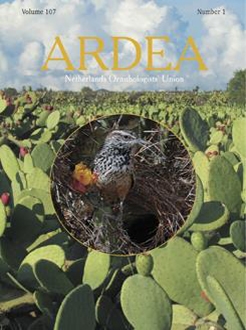As is the case for most avian species, there is considerable variation in the egg size of Continental Black-tailed Godwits Limosa l. limosa breeding in The Netherlands. It is interesting that egg size has costs and benefits yet varies considerably at the population level. To better understand this variation in egg size, we tested its relationship to a suite of individual and environmental factors. We found that egg size can decrease up to 2.8% throughout a breeding season and that egg size increases with clutch size by 1.4% with each additional egg in the clutch. Female body mass and body size explained 5% of the total variation in egg size observed across the population. Furthermore, females wintering south of the Sahara laid 3% smaller eggs than those wintering north of the Sahara. We also found that egg size increases with age, which may indicate age-related differences in the endogenous and/or exogenous conditions of females. The variation in egg size was, however, mostly the result of consistent differences among individuals across years (repeatability = 0.60). A comparison of daughters with mothers suggested that most of this individual repeatability reflects heritable variation (heritability = 0.64). The actual individual traits that underlie this heritable variation among individuals remain mostly undetermined. Smaller eggs did have a slightly lower chance of hatching, but we found no relationship between egg size and chick survival. Finally, nest and chick survival were strongly correlated with lay date. Thus, in Black-tailed Godwits, lay date may actually reflect a female's endogenous and/or exogenous condition at the moment of egg-laying. This finding may be general across birds, since food supplementation experiments usually result in advanced laying and larger clutch sizes rather than in larger eggs.
How to translate text using browser tools
22 January 2020
Variation in Egg Size of Black-Tailed Godwits
Mo A. Verhoeven,
A.H. Jelle Loonstra,
Alice D. McBride,
Joost M. Tinbergen,
Rosemarie Kentie,
Jos C.E.W. Hooijmeijer,
Christiaan Both,
Nathan R. Senner,
Theunis Piersma

Ardea
Vol. 107 • No. 3
December 2019
Vol. 107 • No. 3
December 2019
age
body condition
environmental conditions
parental effort
state




